Small automatic machines (Article III): OTs-11 "Tiss", 9A-91, SR-3 and SR-3M "Whirlwind"
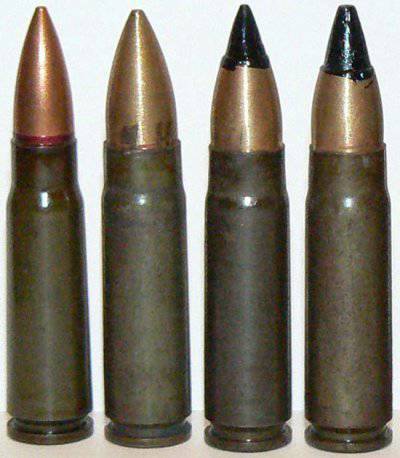 Immediately it should be noted that the new models of small-sized automata were created under slightly different requirements than the weapons of the competition "Modern". So, if previously small dimensions of weapons were due to the fact that they had to be stored inside armored vehicles and without any problems to get them out if necessary, now the weight and dimensions of weapons caused constant wearing of a small-sized machine gun. Such automata were created as weapons that could be hidden to be worn and at the same time effectively used for protected targets and targets behind lightweight shelters. In addition, weapons were required to confidently defeat the enemy when hit, and a relatively short range of use in order to avoid accidental casualties. That is, the machine gun was supposed to use sufficiently powerful ammunition, with a heavy bullet capable of penetrating the means of individual armor. Well, and naturally, the cartridge 5,45х39 could not boast of such properties. To reduce costs, it was decided not to develop a new ammunition, and choose the most suitable of the existing ones; they turned out to be special 9x39 cartridges. Naturally, these cartridges were not cheap at all, and the effective range of weapons using such ammunition does not exclude civilian casualties at a distance of 200-300 meters from the shooter, but in general they are certainly better suited for the assigned tasks compared to 5,45x39. I think that from the acquaintance with ammunition for weapons and should start.
Immediately it should be noted that the new models of small-sized automata were created under slightly different requirements than the weapons of the competition "Modern". So, if previously small dimensions of weapons were due to the fact that they had to be stored inside armored vehicles and without any problems to get them out if necessary, now the weight and dimensions of weapons caused constant wearing of a small-sized machine gun. Such automata were created as weapons that could be hidden to be worn and at the same time effectively used for protected targets and targets behind lightweight shelters. In addition, weapons were required to confidently defeat the enemy when hit, and a relatively short range of use in order to avoid accidental casualties. That is, the machine gun was supposed to use sufficiently powerful ammunition, with a heavy bullet capable of penetrating the means of individual armor. Well, and naturally, the cartridge 5,45х39 could not boast of such properties. To reduce costs, it was decided not to develop a new ammunition, and choose the most suitable of the existing ones; they turned out to be special 9x39 cartridges. Naturally, these cartridges were not cheap at all, and the effective range of weapons using such ammunition does not exclude civilian casualties at a distance of 200-300 meters from the shooter, but in general they are certainly better suited for the assigned tasks compared to 5,45x39. I think that from the acquaintance with ammunition for weapons and should start.Initially, special cartridges 9x39, of course, were created entirely for other purposes, and not for small-sized machines. These munitions were designed, first of all, for silent weapons that would effectively “work” on the purposes protected by personal protective equipment. As you know, the sound of a shot consists of several components: equalizing the pressure of powder gases with the ambient pressure, the sound of the automation, as well as the sound of a bullet flying, which is present if the bullet moves at a speed exceeding the speed of sound. So, if a silent firing device can fight with powder gases, automatics can be silent or rather very quiet, then a bullet to achieve a silent effect should move at subsonic speed. Work on ammunition for silent weapons has been going on for a very long time, but in order not to turn an article on small-sized machines into an article on ammunition, we will limit ourselves only to the predecessor of 9x39 cartridges.
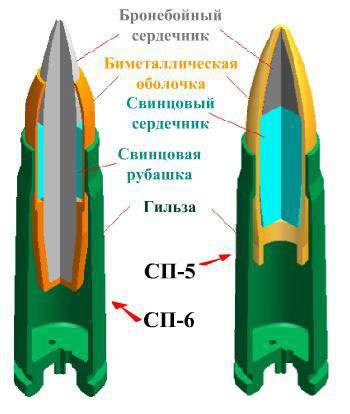 For the successful use of weapons, along with silent firing devices, in the middle of the last century, the 7,62x39US cartridge was developed, whose bullet had a lower speed compared to standard cartridges. These munitions were quite effective for shooting at the enemy unprotected by means of individual armor protection at distances below average, and as body armor became increasingly popular and became more and more perfect, the question of upgrading these cartridges in order to improve their characteristics. One of the main characteristics of the weapon's cartridge is the kinetic energy of the bullet, which depends on two parameters: the speed of the bullet and its weight. Since the speed of the bullet cannot be increased more than the speed of sound, the only way out is to increase its mass, which means an increase in the size of the bullet. The caliber of new cartridges became equal to 9 millimeters, but even then it turned out to be not so simple. It was not enough just to increase the “dope” bullet, as its armor-piercing qualities left much to be desired, so we had to work on the design of the bullet so that it would be effective when it hit the body armor. But about everything in order, especially since there is a 3 version of 9x39 cartridges.
For the successful use of weapons, along with silent firing devices, in the middle of the last century, the 7,62x39US cartridge was developed, whose bullet had a lower speed compared to standard cartridges. These munitions were quite effective for shooting at the enemy unprotected by means of individual armor protection at distances below average, and as body armor became increasingly popular and became more and more perfect, the question of upgrading these cartridges in order to improve their characteristics. One of the main characteristics of the weapon's cartridge is the kinetic energy of the bullet, which depends on two parameters: the speed of the bullet and its weight. Since the speed of the bullet cannot be increased more than the speed of sound, the only way out is to increase its mass, which means an increase in the size of the bullet. The caliber of new cartridges became equal to 9 millimeters, but even then it turned out to be not so simple. It was not enough just to increase the “dope” bullet, as its armor-piercing qualities left much to be desired, so we had to work on the design of the bullet so that it would be effective when it hit the body armor. But about everything in order, especially since there is a 3 version of 9x39 cartridges.The first version of the cartridge 9х39 has the designation SP-5. This ammunition is considered “sniper” and is recommended for use on opponents who are not protected by means of individual armor. To be honest, I would not attribute this cartridge to the high-precision ones, but since among the 9x39 its bullet shows the highest accuracy, then so be it, let it be “sniper”. The bullet of the cartridge SP-5 has a weight in 16 grams, has an armor-piercing core hidden under a bimetallic shell. The length of the bullet itself is equal to 36 millimeters, which turned out to be close to ideal, so that when its weight is provided relatively high ballistic characteristics. SP-6 cartridge is already a purely armor-piercing option. It has a longer bullet with a weight of 16,2 grams and a core protruding from the shell of the bullet, painted black. Thus, these two patrons were divided into “sniper” and “armor-piercing”, now I propose to compare how logical this is. The speed of the bullets of both cartridges is kept at the subsonic limit, the kinetic energy of the bullets does not exceed 700 Joule, SP-6 is guaranteed to punch a steel sheet 8 mm thick at a distance of 100 meters, the same figures for SP-5, but with a steel sheet 6 mm . Thus, it seems to me that the SP-6 is nothing more than the development of the SP-5 cartridge, in which they simply preferred a greater penetrating ability, slightly reducing the accuracy. In addition to these two variants of ammunition, there is a third PUB-9 (armor-piercing automatic cartridge). This ammunition was made as a further development of the SP-6, in which the bullet weight was increased to 17 grams, and there is a gain in speed, but all this worsened the accuracy of the characteristics even more, so usually this cartridge is considered the worst and for some unknown The reason for the cheaper option ammunition 9x39. All of these cartridges are used in weapons that are designed for silent use, because the speed of bullets of cartridges below sound, and since the weight of the bullet cannot be infinitely increased, the kinetic energy of the bullets remains fairly small. All this is more or less acceptable in a silent weapon, but it’s about using in small-sized machines, so I, for example, do not understand why it was impossible to add bullets of these cartridges "meters per second" to the string. However, everything still rests on the fact that the submachine guns considered below should have a range of action just above submachine guns, but higher efficiency, so that you could work on targets with one or two hits and reduce the number of casual victims.
Actually, this is how we approached the discussion of small-sized machines for these cartridges. I will note that there will not be BCC and AU, with which these munitions are usually associated, but it will be quite a usual weapon, if it can be called so small automata. And we’ll actually start with a Kalashnikov assault rifle for this ammunition, because these weapons had very big chances to go into mass production, but, oddly enough, this did not happen and it didn’t help even that production was actually ready for the mass production of this automaton. It is a small-sized machine OTs-11 or "Tiss."
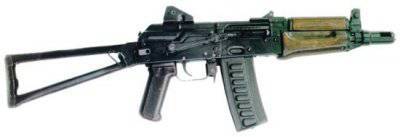 We will not talk much about this weapon, since the Kalashnikov assault rifle is known to everyone. Actually the fact that the weapon is as unified as possible with the common model of the AKS74U is what the designers expected, because everyone knows the reluctance to start production of new samples, and here everything is actually ready, just give a go-ahead to the beginning. The designers of this weapon are Telesh and Lebedev, or rather, in this case, they did not design it, but adapted it for a new ammunition, which is also quite difficult if you want the resulting modification to work for a long time without fail. The completion of the modernization work occurred in 1993, it was by that time that the weapon was completely ready. In the same year, about a hundred automatic machines were created, which were given to the Ministry of Internal Affairs for running in. The weapon received a lot of positive feedback, it was separately mentioned the high efficiency of the machine guns in comparison with AKS74U, but for some unknown reason the weapon was never launched into mass production. Although it seemed that in this case, this sample of a small-sized machine gun was simply doomed to success, thanks to its almost complete similarity with the Kalashnikov machine gun, the production of which had long been mastered and established.
We will not talk much about this weapon, since the Kalashnikov assault rifle is known to everyone. Actually the fact that the weapon is as unified as possible with the common model of the AKS74U is what the designers expected, because everyone knows the reluctance to start production of new samples, and here everything is actually ready, just give a go-ahead to the beginning. The designers of this weapon are Telesh and Lebedev, or rather, in this case, they did not design it, but adapted it for a new ammunition, which is also quite difficult if you want the resulting modification to work for a long time without fail. The completion of the modernization work occurred in 1993, it was by that time that the weapon was completely ready. In the same year, about a hundred automatic machines were created, which were given to the Ministry of Internal Affairs for running in. The weapon received a lot of positive feedback, it was separately mentioned the high efficiency of the machine guns in comparison with AKS74U, but for some unknown reason the weapon was never launched into mass production. Although it seemed that in this case, this sample of a small-sized machine gun was simply doomed to success, thanks to its almost complete similarity with the Kalashnikov machine gun, the production of which had long been mastered and established.Naturally, that did not go completely unchanged. The weapon was replaced with a barrel, a barrel-mounted device, a slightly modified shutter, and also demanded the replacement of a magazine that became the capacity of 20 cartridges. Otherwise, it was up to the trifles AKS74U. The weapon worked due to the removal of powder gases from the barrel, the barrel bore was locked with a bolt when turning two combat stops. Separately, it is worth noting that the sights of the weapons, which have become more convenient, were changed.
Small-sized machine OTs-11 "Tiss" favorably differed from "Ksyusha" new ammunition, which gave less ricochets, had a greater stopping effect and more armor-piercing, also the weapon had a lower impact, which increased the accuracy when conducting automatic fire. In addition, the complete similarity with the AKS74U in the maintenance and management of weapons made it a truly promising model, but did not grow together. There are several reasons for this, but the main one was still in the banal absence of funds. In addition, this weapon didn’t fit in with the requirements for concealed wearing, so as a result, “Tiss” flew like plywood over Paris, breaking the myth that only AK is accepted for armament or what looks like AK. As it turned out, not only the similarity with the Kalashnikov assault rifle plays a role, but also the availability of money.
The second sample, which I propose to meet, is more interesting, since it was developed completely from scratch, and, in my humble opinion, is the best of the whole three presented in this article small-sized machines. In fact, in this small-sized machine gun, the designers managed to achieve what they could not achieve at the Modern competition - a machine gun in size and weight equal to a submachine gun. So, just submit a compact machine called 9А-91 for 9х39 cartridges.
 At first glance, this weapon is very difficult to determine that in front of you a submachine gun or a small-sized machine gun, except that the weapon shop shows what ammunition is used in it. This compact machine is really very compact and light, its length with a folded butt is only 383 millimeters, but with the buttstock spread out, its length grows to 604 millimeters. It is noteworthy that the butt itself is folded up, and in the folded state it is very difficult to determine its presence altogether, it fits so well and does not appear anywhere. By the way, the weapon in general turned out to be very compact and without elements that protrude far beyond its limits, so that if you have a good physique, you can talk about the hidden wearing of this sample small-sized machine gun, however, despite the size and design for concealed carrying, the physique should be very good, and clothing should be adapted to conceal this weapon from prying eyes - not a gun after all.
At first glance, this weapon is very difficult to determine that in front of you a submachine gun or a small-sized machine gun, except that the weapon shop shows what ammunition is used in it. This compact machine is really very compact and light, its length with a folded butt is only 383 millimeters, but with the buttstock spread out, its length grows to 604 millimeters. It is noteworthy that the butt itself is folded up, and in the folded state it is very difficult to determine its presence altogether, it fits so well and does not appear anywhere. By the way, the weapon in general turned out to be very compact and without elements that protrude far beyond its limits, so that if you have a good physique, you can talk about the hidden wearing of this sample small-sized machine gun, however, despite the size and design for concealed carrying, the physique should be very good, and clothing should be adapted to conceal this weapon from prying eyes - not a gun after all.This small-sized automaton was developed in parallel to the more well-known CP-3 “Whirlwind” model, but not only by Klimov designers, but by Tula ones from KBP. This model was designed specifically for employees of the Ministry of Internal Affairs and security, despite the rather expensive ammunition used in weapons. As a result, gunsmiths managed to create a relatively powerful and unconditionally compact version of the weapon with an effective range of fire of up to 200 meters at enemies protected by personal protective equipment and behind light cover. Despite the not very widespread popularity of this sample of the small-sized 9-91, it really is a production model from the 1994 of the year, which speaks of it as a really good sample of weapons that can compete for superiority with the same more famous "Whirlwind".
 The basis of the new weapon was the automatics working on powder gases discharged from the barrel of the machine gun. Locking the barrel of the weapon occurs when you turn the bolt on the 4 combat ledge. Actually, the automation system is quite understandable, and you can even say “classic”, it does not stand out from the total mass of weapons. But the weapons controls are really implemented interestingly, in order to reduce the size of the small-sized machine gun. First of all, you need to mention in this all butt, which was mentioned earlier. The fact is that he really lies down so that at once you will not understand what he is. He absolutely does not cling to anything, even if you try to do it on purpose and more importantly, it does not interfere with the use of arms in the folded state. The second interesting element is the slider switch fuse and fire modes. This is really a slider that will mix horizontally, and it is located in such a way that its switching is possible in both directions with the index finger of the hand holding the pistol grip, which is especially convenient when bringing the weapon on alert when it is required to be done instantly. Well, I think it would be superfluous to talk about the trigger and the store holder. In its original version, the compact machine 9А-91 was equipped with a flame arrester, which was later abandoned, with virtually no damage to the weapon. It is also worth noting that, despite its not very heavy weight in 2,1 kilograms, the weapon is fully made in metal, the only plastic parts are the halves of the shank and the pistol grip, which provides the weapon with a sufficiently high mechanical strength even with the most barbaric treatment. But the reliability in adverse conditions was far from being so smooth. The fact is that, in fact, the openness of the whole gut of the small-sized 9-91 submachine gun made it very, very susceptible to various kinds of pollution. Of course, the weapon transfers fine dust and a small amount of sand, but on the whole it is very negative about any external “irritant”. However, if you think logically, the purpose of the weapon provides for its use in virtually “sterile” conditions, although the safety margin of 9-91 would obviously not be superfluous, but it seems there are no complaints about this.
The basis of the new weapon was the automatics working on powder gases discharged from the barrel of the machine gun. Locking the barrel of the weapon occurs when you turn the bolt on the 4 combat ledge. Actually, the automation system is quite understandable, and you can even say “classic”, it does not stand out from the total mass of weapons. But the weapons controls are really implemented interestingly, in order to reduce the size of the small-sized machine gun. First of all, you need to mention in this all butt, which was mentioned earlier. The fact is that he really lies down so that at once you will not understand what he is. He absolutely does not cling to anything, even if you try to do it on purpose and more importantly, it does not interfere with the use of arms in the folded state. The second interesting element is the slider switch fuse and fire modes. This is really a slider that will mix horizontally, and it is located in such a way that its switching is possible in both directions with the index finger of the hand holding the pistol grip, which is especially convenient when bringing the weapon on alert when it is required to be done instantly. Well, I think it would be superfluous to talk about the trigger and the store holder. In its original version, the compact machine 9А-91 was equipped with a flame arrester, which was later abandoned, with virtually no damage to the weapon. It is also worth noting that, despite its not very heavy weight in 2,1 kilograms, the weapon is fully made in metal, the only plastic parts are the halves of the shank and the pistol grip, which provides the weapon with a sufficiently high mechanical strength even with the most barbaric treatment. But the reliability in adverse conditions was far from being so smooth. The fact is that, in fact, the openness of the whole gut of the small-sized 9-91 submachine gun made it very, very susceptible to various kinds of pollution. Of course, the weapon transfers fine dust and a small amount of sand, but on the whole it is very negative about any external “irritant”. However, if you think logically, the purpose of the weapon provides for its use in virtually “sterile” conditions, although the safety margin of 9-91 would obviously not be superfluous, but it seems there are no complaints about this.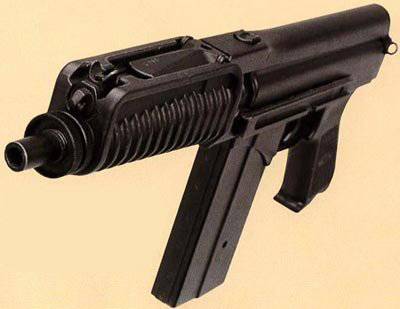 Based on all the above, we can conclude that the weapon was not only compact, it is also very convenient to use. Perhaps the only drawback of this small-sized machine gun can only be called sighting devices, which are made very small and with a rather short sighting line, but it is quite enough to conduct effective fire at a distance of up to 200 meters. In addition to the open sights, consisting of a pillar and front sight, on the left side of the weapon is a seat for the installation of additional sighting devices that can make the weapon more comfortable to use. In addition, you can not go past the direct store of weapons with a capacity of 20 ammunition that can easily fit in your pocket and does not have any protruding elements that can catch on the clothes when removed. So whatever one may say, this small-sized machine fully meets all requirements.
Based on all the above, we can conclude that the weapon was not only compact, it is also very convenient to use. Perhaps the only drawback of this small-sized machine gun can only be called sighting devices, which are made very small and with a rather short sighting line, but it is quite enough to conduct effective fire at a distance of up to 200 meters. In addition to the open sights, consisting of a pillar and front sight, on the left side of the weapon is a seat for the installation of additional sighting devices that can make the weapon more comfortable to use. In addition, you can not go past the direct store of weapons with a capacity of 20 ammunition that can easily fit in your pocket and does not have any protruding elements that can catch on the clothes when removed. So whatever one may say, this small-sized machine fully meets all requirements.It is noteworthy that the regular patron for this machine became not SP-5 or SP-6, but PUB-9. This happened because in production this ammunition is slightly cheaper in terms of materials, although the production itself is also laborious. In view of this, when adopting the small-sized machine 9А-91, they decided to save at least a little. However, the fact that out of the whole troop of ammunition PUB-9 is a cartridge with the lowest accuracy, is in fact not reflected in any way in the practical use of weapons up to 200 meters. Thus, the bullet of this cartridge pierces all body armor up to the 3 class, inclusive, and is also able to pierce a sheet of steel with a thickness of 8 millimeters at a distance of up to 100 meters, which is enough to complete the tasks assigned to such a weapon.
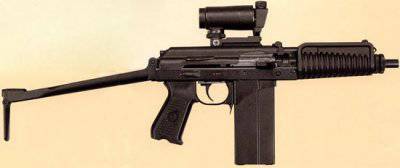 It is also noteworthy that in addition to the version for 9x39 cartridges, budget versions of weapons for 5,45 and 7,62 cartridges (“budget” in ammunition value), as well as an export version for NATO cartridge 5,56, were not developed, but these options for the small-sized machine gun were not distributed. When creating weapons for various cartridges, the designers did not calm down and decided to equip this small-sized machine gun with a silent shooting device, as well as! ATTENTION! grenade launcher. However, the latter could not be implemented in view of the small mass of the weapon and its design, which, although it withstood a shot from a grenade launcher, but the shooter did not. Thus, before the same "Swirl" small-sized machine 9А-91 has a tangible advantage in the form of having its own device for silent shooting and a wide range of ammunition. In addition, this small-sized machine became the basis for the creation of such weapons as VSK-94, which is a clear competitor of ARIA, although it loses in some cases. In general, in my opinion, 9A-91 is the clear leader among the small-sized machines for 9x39 cartridges.
It is also noteworthy that in addition to the version for 9x39 cartridges, budget versions of weapons for 5,45 and 7,62 cartridges (“budget” in ammunition value), as well as an export version for NATO cartridge 5,56, were not developed, but these options for the small-sized machine gun were not distributed. When creating weapons for various cartridges, the designers did not calm down and decided to equip this small-sized machine gun with a silent shooting device, as well as! ATTENTION! grenade launcher. However, the latter could not be implemented in view of the small mass of the weapon and its design, which, although it withstood a shot from a grenade launcher, but the shooter did not. Thus, before the same "Swirl" small-sized machine 9А-91 has a tangible advantage in the form of having its own device for silent shooting and a wide range of ammunition. In addition, this small-sized machine became the basis for the creation of such weapons as VSK-94, which is a clear competitor of ARIA, although it loses in some cases. In general, in my opinion, 9A-91 is the clear leader among the small-sized machines for 9x39 cartridges.And finally, the last small-sized automaton in this article and in the entire series of articles is CP-3 “Whirlwind”. This small-sized machine gun was created for all the same purposes as the previous ones, the main requirement for the creation of this weapon was its small size and weight, which the designers were able to achieve, at least in the first version of the weapon. This small-sized machine gun was supposed to be the main weapon in protecting state officials, conducting anti-terrorist operations, and also in the long term replacing AKS74U in the army’s armament as personal weapons for armored vehicles, drivers, and so on, due to the higher cost of 9x39 ammunition compared to 5,45x39 did not happen and will not happen, which can not but grieve. Nevertheless, the Vortex compact machine is a fairly well-known model of weapons, mainly due to the interest in 9x39 cartridges, but this model is not a silent weapon, unlike AU and BCC, at least with CBE.
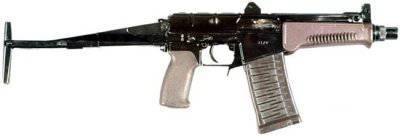 This small-sized machine gun is made on the basis of a special Val machine gun, from which he borrowed many elements, including automation, which works on the basis of removal of powder gases from the bore of the weapon, allows firing both in single shots and in a queue. The bore is locked when the shutter is turned on the 6 protrusions. In general, to be honest, "Whirlwind" and can be called "Val" with minor changes that were made in the absence of noiselessness and reduce the size of the weapon. So, the barrel of a small-sized machine gun does not have openings for removal of powder gases, and the receiver is reduced where it is only possible. The weight of the CP-3 “Whirlwind” compact machine is 2 kilogram, while the length of the weapon with the butt folded is equal to 360 millimeters, with the unfolded - 610. The length of the barrel is 156 millimeters. The machine feeds from detachable magazines with a capacity of 10 and 20 cartridges, the rate of fire of the weapon is 900 rounds per minute. The effective range of the small-sized machine is 200 meters, which is not surprising with the barrel 156 mm.
This small-sized machine gun is made on the basis of a special Val machine gun, from which he borrowed many elements, including automation, which works on the basis of removal of powder gases from the bore of the weapon, allows firing both in single shots and in a queue. The bore is locked when the shutter is turned on the 6 protrusions. In general, to be honest, "Whirlwind" and can be called "Val" with minor changes that were made in the absence of noiselessness and reduce the size of the weapon. So, the barrel of a small-sized machine gun does not have openings for removal of powder gases, and the receiver is reduced where it is only possible. The weight of the CP-3 “Whirlwind” compact machine is 2 kilogram, while the length of the weapon with the butt folded is equal to 360 millimeters, with the unfolded - 610. The length of the barrel is 156 millimeters. The machine feeds from detachable magazines with a capacity of 10 and 20 cartridges, the rate of fire of the weapon is 900 rounds per minute. The effective range of the small-sized machine is 200 meters, which is not surprising with the barrel 156 mm.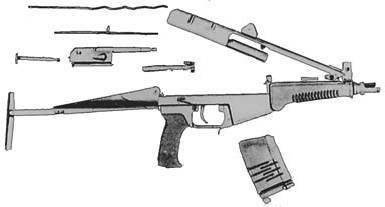 A remarkable point is that the CP-3 does not have the ability to install a silent-firing device, unlike its later modification. The butt of a small-sized machine is folded up and does not interfere with conducting a sufficiently effective fire in the folded state. The barrel of the weapon is not equipped with a flame arrester. The trigger mechanism of the weapon is completely identical to the trigger of the “Val” machine gun, but the controls have been changed. So, the fuse switch is placed on both sides of the weapon and made more convenient and accessible to switch. And the fire mode switch is made in the form of a button behind the trigger, which moves across the weapon, which, in my opinion, is very inconvenient, but this is a matter of taste and habit. The shutter handle of the weapon was replaced by two protrusions that were brought forward and located above the gun forearm, which is also not the best solution, as you can easily injure your fingers if the grip is unsuccessful. So in this case, the plus from the smaller thickness of the weapon is quite controversial, although reloading with such controls is undoubtedly more convenient for a small-sized machine gun. Of the plastic parts in the weapon there is only a pistol grip and handguard, everything else is metallic, despite the low weight of the weapon, which makes this small-sized machine sufficiently durable. The sights of the weapon are the simplest, consist of their pillar and front sight with a short line of aiming, which, in principle, is enough to conduct effective fire at distances up to 200 meters. The height of the sighting devices may seem unnecessary, but this was done so that they can be used when the butt of the weapon is complicated, so that the height of the rear sight and the front sight is quite justified.
A remarkable point is that the CP-3 does not have the ability to install a silent-firing device, unlike its later modification. The butt of a small-sized machine is folded up and does not interfere with conducting a sufficiently effective fire in the folded state. The barrel of the weapon is not equipped with a flame arrester. The trigger mechanism of the weapon is completely identical to the trigger of the “Val” machine gun, but the controls have been changed. So, the fuse switch is placed on both sides of the weapon and made more convenient and accessible to switch. And the fire mode switch is made in the form of a button behind the trigger, which moves across the weapon, which, in my opinion, is very inconvenient, but this is a matter of taste and habit. The shutter handle of the weapon was replaced by two protrusions that were brought forward and located above the gun forearm, which is also not the best solution, as you can easily injure your fingers if the grip is unsuccessful. So in this case, the plus from the smaller thickness of the weapon is quite controversial, although reloading with such controls is undoubtedly more convenient for a small-sized machine gun. Of the plastic parts in the weapon there is only a pistol grip and handguard, everything else is metallic, despite the low weight of the weapon, which makes this small-sized machine sufficiently durable. The sights of the weapon are the simplest, consist of their pillar and front sight with a short line of aiming, which, in principle, is enough to conduct effective fire at distances up to 200 meters. The height of the sighting devices may seem unnecessary, but this was done so that they can be used when the butt of the weapon is complicated, so that the height of the rear sight and the front sight is quite justified.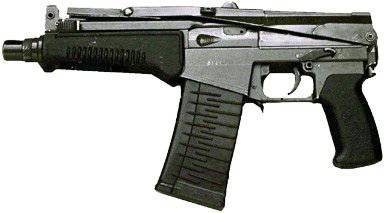 Despite all of the above, “Whirlwind” did not last long in this form. After adopting a small-sized machine gun, the FSB almost immediately put forward new requirements for a small-sized model. And the requirements were virtually impossible to implement, since they had to endow the Whirlwind with the capabilities and characteristics of the special Val automatic rifle and the accuracy of the special Vintorez sniper rifle. Since the requirements were put forward, the designers fulfilled them as far as they could, donating in arms virtually everything that made him unique in its own way. This is how CP-3M appeared.
Despite all of the above, “Whirlwind” did not last long in this form. After adopting a small-sized machine gun, the FSB almost immediately put forward new requirements for a small-sized model. And the requirements were virtually impossible to implement, since they had to endow the Whirlwind with the capabilities and characteristics of the special Val automatic rifle and the accuracy of the special Vintorez sniper rifle. Since the requirements were put forward, the designers fulfilled them as far as they could, donating in arms virtually everything that made him unique in its own way. This is how CP-3M appeared.First of all, the changes affected the mass and dimensions of the weapon. The length of the small-sized machine gun has grown to 410 millimeters with a folded butt and to 675 with unfolded, while the butt itself is now folded to the left and was borrowed from a special Val machine. It is interesting that the sights remained the same high from the CP-3, but in addition to them, the attachment plate for additional devices appeared on the left side of the weapon. Naturally, it became possible to install a silent-firing device, with which the length of the weapon was equal to 970 millimeters with the butt folded and 700 millimeters with the folded. Firing from a weapon with a folded butt remained possible, but the butt overlapped the fore-end, which made the retention of a small-sized machine gun completely inconvenient, because an additional handle was fastened to the forearm.
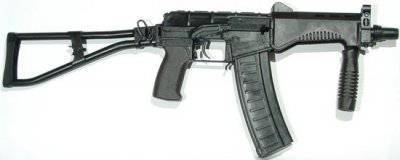 Much remains unchanged. Thus, the automatic weapons still worked on the powder gases discharged from the barrel, and the barrel itself locked when the bolt was turned to the 6 protrusions. The trigger mechanism also remained from the special “Val” submachine gun, allowing firing with single shots and a burst. The protrusions of the bolt protruding forward have been replaced with one handle, which is located in its “classic” place. The fuse switch in a position where the weapon is completely safe, is positioned in such a way that it is not possible to fully delay the bolt. The switch of fire modes is made in the form of a lever swinging in the transverse plane located immediately behind the trigger of the weapon. In addition, more weapon stores for 30 cartridges have appeared for weapons, but previous versions of 10 and 20 cartridges can also be used.
Much remains unchanged. Thus, the automatic weapons still worked on the powder gases discharged from the barrel, and the barrel itself locked when the bolt was turned to the 6 protrusions. The trigger mechanism also remained from the special “Val” submachine gun, allowing firing with single shots and a burst. The protrusions of the bolt protruding forward have been replaced with one handle, which is located in its “classic” place. The fuse switch in a position where the weapon is completely safe, is positioned in such a way that it is not possible to fully delay the bolt. The switch of fire modes is made in the form of a lever swinging in the transverse plane located immediately behind the trigger of the weapon. In addition, more weapon stores for 30 cartridges have appeared for weapons, but previous versions of 10 and 20 cartridges can also be used. Thus, it turned out a sort of mutant, striving for universality, which, as is well known, cannot be achieved in weapons business, and the pursuit of this universality ends exactly with the result that is described. As a result, not the most reasonable requirements that were put forward during the modernization of the CP-3, the weapon lost its main advantages over the 9-91, making it the absolute leader among the small-sized machines for 9X39 cartridges. At the same time, 9-91 initially had the ability to install a silent-firing device, which allowed him to jump a little ahead of CP-3. Nevertheless, both small-sized machines are mass-produced and are in service, although from an economic point of view, the Whirlwind still has an advantage, since it is very tightly unified with the special Val. On the other hand, 9A-91 boasts that it is not alone, thanks to VSK-94. But if with VSK-94 not everything is as it would be desirable for designers, then here among small-sized automats under the cartridges 9х39 they won an unconditional victory. However, here it is impossible to say that someone bothered better than anyone else. Both the model and the model came out quite decent, but the fact that the “Whirlwind” as a small-sized machine loses the 9А-91 can be explained by the dubious demands that were put forward by the designers. Plus, we should not forget that at the time when this weapon was created, such a beautiful thing as “modularity” just started to be thought of here, and in fact you can see the first and somewhere awkward steps in this direction. Also, do not forget that the time of the creation of these weapons fell on the beginning of the 90-x, and the time was very difficult, including for the "defense".
Thus, it turned out a sort of mutant, striving for universality, which, as is well known, cannot be achieved in weapons business, and the pursuit of this universality ends exactly with the result that is described. As a result, not the most reasonable requirements that were put forward during the modernization of the CP-3, the weapon lost its main advantages over the 9-91, making it the absolute leader among the small-sized machines for 9X39 cartridges. At the same time, 9-91 initially had the ability to install a silent-firing device, which allowed him to jump a little ahead of CP-3. Nevertheless, both small-sized machines are mass-produced and are in service, although from an economic point of view, the Whirlwind still has an advantage, since it is very tightly unified with the special Val. On the other hand, 9A-91 boasts that it is not alone, thanks to VSK-94. But if with VSK-94 not everything is as it would be desirable for designers, then here among small-sized automats under the cartridges 9х39 they won an unconditional victory. However, here it is impossible to say that someone bothered better than anyone else. Both the model and the model came out quite decent, but the fact that the “Whirlwind” as a small-sized machine loses the 9А-91 can be explained by the dubious demands that were put forward by the designers. Plus, we should not forget that at the time when this weapon was created, such a beautiful thing as “modularity” just started to be thought of here, and in fact you can see the first and somewhere awkward steps in this direction. Also, do not forget that the time of the creation of these weapons fell on the beginning of the 90-x, and the time was very difficult, including for the "defense".I wouldn’t have been me if I hadn’t remembered the question that emerges in each of the three articles on small-sized machines. This question is how applicable such weapons are in the urban area of a peaceful city, and it arises primarily because the PPS weapons are just one of the small machines of the Modern contest - AKS74U. There can be at least two opinions here: the opinion of just a city resident and the opinion of one who is armed with such weapons, the opinion of someone who will shoot, I think, can be ignored. The weapon uses an 5,45x39 cartridge, that is, a full-fledged ammunition, which even from a short Ksyusha barrel can fly far enough and with good speed, so if you went out for bread and a similar weapon is used half a kilometer away, you have a chance to catch a bullet which is not meant for you at all. Accordingly, with such a probability, the opinion of a civilian-lover of bread will be very negative to such weapons. The shooter who used the weapon will not have the most positive opinion either, since, first, he will have to explain a long and dreary reason why the bullet flew not to where he wanted, and secondly, the 5,45 is far from an ideal cartridge, which will be able to stop the enemy from the first hit. So the shooter from such a weapon is not thrilled, respectively, in this case, the best option would be a submachine gun with any "evil" bullets that turn everything inside when hit, but do not fly long distances. The only disadvantage of such a weapon is that if an enemy is protected by a bulletproof vest, then the fastest such bullet will not penetrate it. However, there are two arguments here as opposed to: the criminals in body armor do not walk so often, and even after the bullet hit the body armor only in the movie, the hero remains capable and does not notice hits at all. Better, it seems, things are with ammunition 9x39 and weapons under them. It flies nearby not far, it has good armor-piercing and a stopping effect, which is quite good in comparison with 5,45, however, both weapons and ammunition are expensive. And despite the fact that the speed of the bullet is small, and the range of the flight a small cartridge still remains “automatic” with all the ensuing consequences. From this we can conclude that small-sized machines can only be used in a military environment, and are not intended for mass armament in the Ministry of Internal Affairs. In the end, you can use a submachine gun for 9x21 ammunition, equip it with ordinary ammunition, and just in case keep a magazine with armor-piercing, more expensive cartridges. Of course, the Ministry of Internal Affairs needs both full-fledged and small-sized and special automata, but they should not be used everywhere, however cheap and angry it may be. But this is just my opinion on the vision of the issue of distribution of small-sized machines.
This is the end of the series of articles on small-sized machines. Of course, not all samples of weapons with compact dimensions and powered by "automatic" cartridges were considered, but I think that I managed to single out the most interesting and common ones. If we raise the question of whether there are analogs among foreign models, then they, of course, will be available, but in our country such samples have become much more widespread and actually formed another class of weapons between full-fledged machine guns and submachine guns. It is not for nothing that such small-sized assault rifles are often referred to as PP, especially in the West, but we are literate people and we will not violate the classification of weapons. However, if they like to refer our samples to submachine guns, then you are always welcome, so we will have a clear superiority in this class of weapons, since no cartridge intended for a pistol can compete with a full-fledged "automatic" ammunition.
- Karasik Kirill
- weaponland.ru
Information